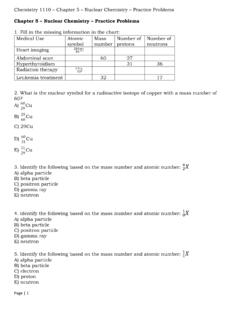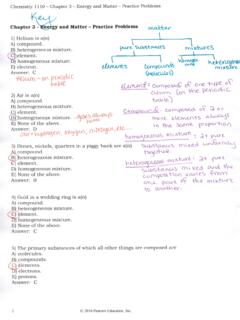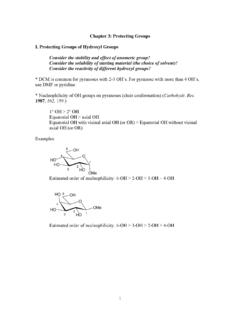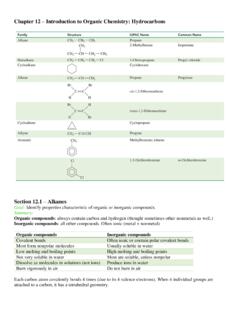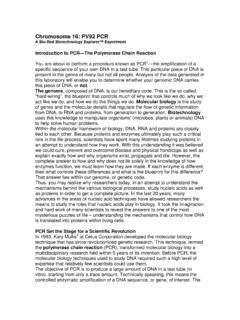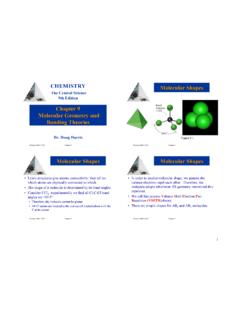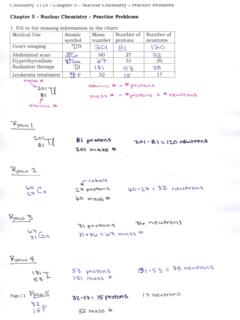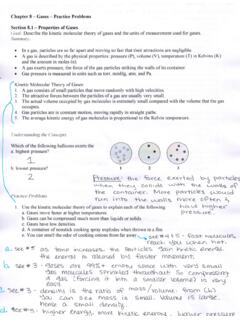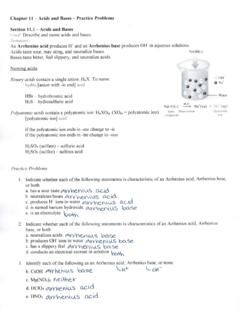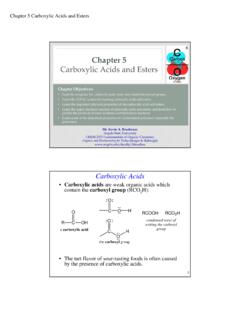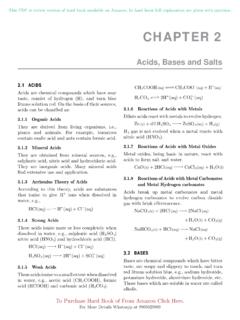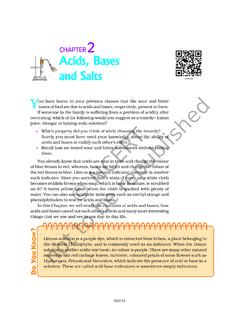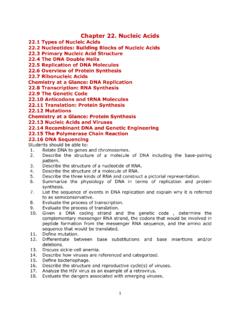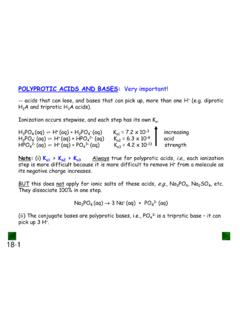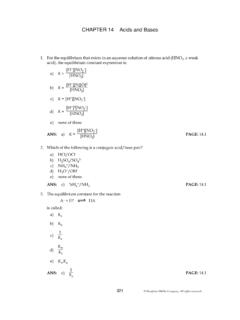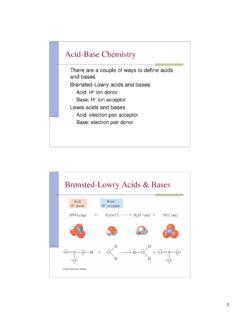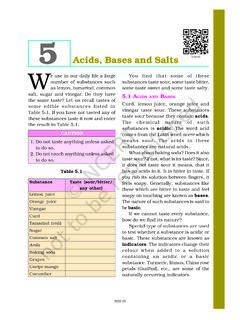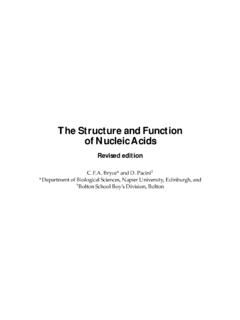Transcription of Chapter 11 Acids and Bases Practice Problems Section 11.1 ...
1 Chapter 11 Acids and Bases Practice Problems Section Acids and Bases Goal: Describe and name Acids and Bases . Summary: An Arrhenius acid produces H+ and an Arrhenius base produces OH- in aqueous solutions. Acids taste sour, may sting, and neutralize Bases . Bases taste bitter, feel slippery, and neutralize Acids . Naming Acids : Binary Acids contain a single anion: HnX. To name: hydro [anion with -ic end] acid HBr hydrobromic acid H2S hydrosulfuric acid Polyatomic Acids contain a polyatomic ion: HnXOm (XOm = polyatomic ion) [polyatomic ion] acid if the polyatomic ion ends in -ate change to -ic if the polyatomic ion ends in -ite change to -ous H2SO4 (sulfate) sulfuric acid H2SO3 (sulfite) sulfous acid Practice Problems 1.
2 Indicate whether each of the following statements is characteristic of an Arrhenius acid , Arrhenius base , or both: a. has a sour taste b. neutralizes Bases c. produces H+ ions in water d. is named barium hydroxide e. is an electrolyte 2. Indicate whether each of the following statements is characteristics of an Arrhenius acid , Arrhenius base , or both: a. neutralizes Acids b. produces OH- ions in water c. has a slippery feel d. conducts an electrical current in solution 3. Identify each of the following as an Arrhenius acid , Arrhenius base , or none: b.
3 CsOH c. Mg(NO3)2 d. HClO4 e. HNO2 f. MgBr2 g. NH3 h. Li2SO3 4. Name each of the following Acids or Bases : a. HCl b. Ca(OH)2 c. HClO4 d. HNO3 e. H2SO3 5. Name each of the following Acids or Bases : a. Al(OH)3 b. H2SO4 c. HBr d. KOH e. HNO2 f. HClO2 6. Write formulas for each of the following Acids or Bases : a. rubidium hydroxide b. hydrofluoric acid c. phosphoric acid d. lithium hydroxide e. ammonium hydroxide 7. Write formulas for each of the following Acids or Bases : a. barium hydroxide b. hydroiodic acid c. nitric acid d. acetic acid e.
4 Hypochlorous acid Section Bronsted-Lowery Acids Goal: Identify conjugate acid - base pairs for Bronsted-Lowry Acids and Bases . Summary: A Bronsted-Lowry acid donates H+ and a Bronsted-Lowry base accepts H+. Identifying Conjugate acid - base Pairs According to Bronsted-Lowry theory, a conjugate acid - base pair consists of molecules or ions related by the loss of one H+ by an acid , an the gain of one H+ by a base . Every acid - base reaction contains two conjugate acid - base pairs because an H+ is transferred in both the forward and reverse directions.
5 When an acid such as HF loses one H+, the conjugate base F- is formed. When H2O acts as a base , it gains one H+, which forms its conjugate acid , H3O+. Practice Problems 8. Write the formula for the conjugate base for each of the following Acids : a. HCO3- b. HPO42- c. HBrO 9. Write the formula for the conjugate acid for each of the following Bases : a. CO32- b. H2O c. H2PO4- 10. In the following reaction, the acid -conjugate base pair is __i__ and the base -conjugate acid pair is __ii__. H3PO4(aq) + H2O(l) H2PO4-(aq) + H3O+(aq) a.
6 (i) H3PO4/H3O+ (ii) H2O/H2PO4- b. (i) H3PO4/H2O (ii) H2PO4-/H3O+ c. (i) H2O/H3O+ (ii) H3PO4/H2PO4- d. (i) H2O/H2PO4- (ii) H3PO4/H3O+ e. (i) H3PO4/H2PO4- (ii) H2O/H3O+ 11. In the following reaction, the acid -conjugate base pair is __i__ and the base -conjugate acid pair is __ii__. CO32-(aq) + H2O(l) HCO3-(aq) + OH-(aq) a. (i) CO32-/ H2O (ii) HCO3-/OH- b. (i) H2O/HCO3- (ii) CO32-/OH- c. (i) H2O/OH- (ii) CO32-/HCO3- d. (i) CO32-/OH- (ii) H2O/HCO3- e. (i) CO32-/HCO3- (ii) H2O/OH- 12. In the following reaction, the acid -conjugate base pair is __i__ and the base -conjugate acid pair is __ii__.
7 H3PO4(aq) + NH3(aq) H2PO4-(aq) + NH4+(aq) a. (i) H3PO4/H2PO4- (ii) NH3/NH4+ b. (i) H3PO4/NH4+ (ii) NH3/H2PO4- c. (i) H3PO4/NH3 (ii) H2PO4-/NH4+ d. (i) H2PO4-/H3PO4 (ii) NH4+/NH3 e. (i) NH3/NH4+ (ii) H3PO4/H2PO4- 13. Complete the following table: acid Conjugate base HI Cl- NH4+ HS- 14. Complete the following table: base Conjugate acid F- HC2H3O2 HSO3- ClO- 15. When ammonium chloride dissolves in water, the ammonium ion NH4+ donates an H+ to water. Write a balanced equation for the reaction of the ammonium ion with water.
8 A. NH4+ + H2O NH3 + H3O+ b. NH4+ + H3O+ NH3 + H2O + H+ c. NH4+ + H3O+ NH3 + H2O + OH- d. NH3 + H2O NH2- + H3O+ e. NH3 + H3O+ NH4+ + H2O 16. When sodium carbonate dissolves in water, the carbonate ion CO32- acts as a base . Write a balanced equation for the reaction of the carbonate ion with water. a. CO32- + H2O CO2 + H3O+ b. CO32- + H2O HCO3- + OH- c. CO32- + H2O H2CO4 d. CO32- + OH- CO32- + H2O e. CO32- + H2O H2CO3 Section Strengths of Acids and Bases Goal: Write equations for the dissociation of strong and weak Acids ; identify the direction of reaction.
9 Summary: Strong Acids dissociate completely in water, and the H+ is accepted by H2O acting as a base . HCl + H2O H3O+ + Cl- A weak acid dissociates only slightly in water, producing only a small amount of H+ and therefore a small amount of H3O+ HI + H2O H3O+ + I- Strong Bases are hydroxides with metals from Groups 1 and 2 and dissociate completely in water. (NaOH, Ca(OH)2, ..) An important weak base is ammonia, NH3. Understanding the Concepts: In diagrams A and B, determine if the diagram represents a strong acid or a weak acid .
10 The acid has the formula HX. Practice Problems 17. Using Table , identify the stronger acid in each of the following pairs: a. NH4+ or H3O+ b. H2SO4 or HCl c. H2O or H2CO3 18. Using Table , identify the weaker acid in each of the following pairs: a. HCl or HSO4- b. HNO2 or HF c. HCO3- or NH4+ 19. Predict whether the following reaction contains mostly reactants or products at equilibrium: H2CO3(aq) + H2O(l) HCO3-(aq) + H3O+(aq) a. mostly products b. mostly reactants 20. Predict whether the following reaction contains mostly reactants or products at equilibrium: NH4+(aq) + H2O(l) NH3(aq) + H3O+(aq) a.
